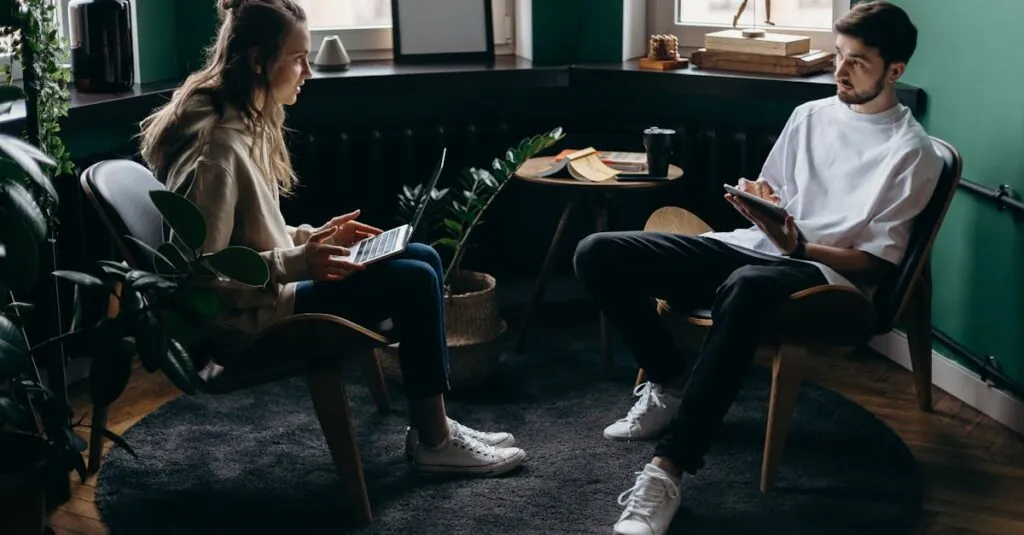Table of Contents
ToggleIn a world where bigger isn’t always better, tiny homes have taken center stage, proving that less really can be more. But how do you turn that dream of downsizing into a reality without losing your sanity? Enter tiny home design software—the secret weapon for aspiring minimalist architects and accidental DIY enthusiasts alike.
Overview Of Tiny Home Design Software
Tiny home design software offers users tools to visualize and plan their living spaces effectively. Architects and DIY enthusiasts benefit from user-friendly interfaces that simplify the process. Programs like SketchUp and Home Designer Suite provide features tailored for small-scale designs, including floor planning, 3D modeling, and material selection.
Accessibility is crucial in this software, allowing users to experiment with layouts quickly. Users can input specific dimensions, ensuring their designs meet individual needs. Additionally, many software options come with libraries of furniture and fixtures suited for tiny homes, making it easier to visualize arrangements.
Some software packages provide advanced functionalities, such as virtual reality walkthroughs. These features enhance user experience by allowing individuals to explore designs before construction begins. Cloud-based solutions enable collaboration, facilitating communication among family members or design teams.
Costs vary across different software options, with some offering free trials. Pricing generally ranges from $0 to $500, depending on features and capabilities. Users can choose based on expertise levels, purpose, and budget constraints, ensuring a suitable match for their project.
Overall, tiny home design software plays a vital role in maximizing space efficiency and functionality. It empowers individuals to create personalized minimalistic living areas without overwhelming stress. By leveraging technology, aspiring tiny homeowners can transform their ideas into practical designs.
Key Features To Consider
When exploring tiny home design software, several key features significantly enhance the design experience. These features streamline the process and ensure a productive journey toward creating a minimalist living space.
User Interface and Usability
Intuitive user interfaces make tiny home design software accessible to all skill levels. An easy-to-navigate layout simplifies the learning curve for beginners, allowing them to engage with the software faster. Advanced users benefit from customizable toolbars that improve efficiency. Clear instructions and tutorials further assist users in maximizing the software’s potential. Multiplatform compatibility ensures significant design flexibility, letting users work on various devices seamlessly.
Design Tools and Capabilities
Robust design tools cater specifically to tiny home projects, enabling users to create detailed floor plans and 3D models. Essential features, such as drag-and-drop functionality, facilitate the quick arrangement of furniture and fixtures. Moreover, realistic rendering options help visualize designs effectively. Design software often includes templates tailored for tiny spaces, streamlining project initiation. Various libraries stocked with furniture options enhance customization and alignment with the user’s unique style.
Budgeting and Cost Estimation
Effective budgeting tools play a crucial role in the design process, guiding users toward realistic cost projections. Software that allows itemized expense tracking helps users remain within their financial limits. Cost estimation features offer insights into potential expenses for different materials and layouts, ensuring well-informed decisions. Some platforms even provide financing options or links to purchasing resources. Integration with expense management tools further aids in maintaining budget accuracy, streamlining the overall planning process.
Popular Tiny Home Design Software Options
A variety of tiny home design software options facilitate the creation of efficient living spaces. Below are three noteworthy software programs.
SketchUp
SketchUp stands out for its user-friendly interface and versatile tools. Users can create detailed 3D models and manipulate designs with ease. Floor planning features enable precision, accommodating specific dimensions for tiny homes. Integration with extensive libraries allows access to furniture and fixtures that fit smaller spaces. New users appreciate the learning resources available, offering tutorials and support. This software also supports virtual reality walkthroughs, enhancing the user experience. Pricing begins with a free version, while the professional edition costs around $299 annually.
Home Designer Suite
Home Designer Suite suits both DIY enthusiasts and professionals seeking comprehensive design capabilities. This software includes robust tools for 2D and 3D design, ensuring accuracy in floor plans. Users can visualize interior layouts with realistic renderings, making design decisions simpler. The program provides extensive material options for finishes and fixtures, ideal for tiny home customization. Collaboration features enable users to share designs with family and friends effortlessly. The cost varies, with one-time purchases typically around $99, making it accessible for those focusing on budget-friendly options.
RoomSketcher
RoomSketcher delivers intuitive design capabilities paired with impressive visualization options. Its drag-and-drop interface makes creating floor plans quick and easy. Users can generate 3D visualizations and virtual tours, offering an immersive design experience. Small-space planners benefit from customizable libraries stocked with small furniture and decor items. This software also allows budget tracking, aiding users in managing expenses efficiently. Subscription plans start around $49 per year, ensuring it meets various financial needs while providing valuable design tools.
Benefits Of Using Tiny Home Design Software
Tiny home design software offers numerous advantages that streamline the design process. Enhanced visualization tools allow users to see their ideas come to life in 3D, ensuring they can make informed decisions about space and layout. With intuitive interfaces, both beginners and seasoned designers can navigate the software without frustration.
Customization options remain a key benefit. Users can input specific dimensions and experiment with various layouts, finding configurations that fit their unique needs. Libraries filled with furniture and fixtures enable quick integration of design elements, making it easy to envision the final product.
Collaboration features also stand out. Cloud-based solutions facilitate sharing ideas among family, friends, or professional design teams. This collaborative approach can lead to better-informed design choices, tapping into diverse perspectives and ensuring all preferences are considered.
Cost-effectiveness provides another reason to adopt these tools. Many software options feature free trials, allowing users to explore functionalities before committing. Pricing ranges from $0 to $500, accommodating individuals with different budgetary constraints.
Advanced functionalities like virtual reality walkthroughs enhance the experience further. Users can “walk” through their designs, identifying areas for improvement before construction begins. Such capabilities can save time and resources, ultimately leading to a more successful end result.
Overall, tiny home design software plays a crucial role in maximizing creativity and efficiency, making it easier for anyone to create a functional and personalized living space in a compact home.
Tiny home design software is revolutionizing the way individuals approach minimalist living. By providing intuitive tools and advanced functionalities, it empowers users to visualize and create their dream spaces with ease. Whether someone is a seasoned architect or a first-time DIYer, these programs enhance the design process and make it accessible to all.
The variety of options available ensures that everyone can find a solution that fits their needs and budget. With features like 3D modeling and virtual reality walkthroughs, users can experiment and refine their designs before breaking ground. As the tiny home movement continues to grow, the role of design software becomes increasingly vital in helping people embrace a simpler, more efficient lifestyle.







